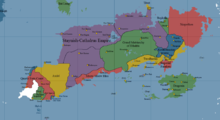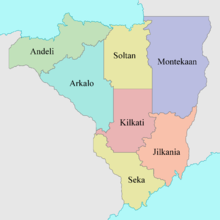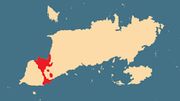Difference between revisions of "Axdel"
m |
m |
||
| Line 8: | Line 8: | ||
|national_motto = ''"Rise Through Revolution"'' | |national_motto = ''"Rise Through Revolution"'' | ||
|national_anthem = ''"Hardship of the past"'' | |national_anthem = ''"Hardship of the past"'' | ||
| − | |image_map = | + | |image_map = AURORA MAP 23RD DEC 2016.PNG |
|loctext = Map | |loctext = Map | ||
|map_caption = Location of Axdel on the continent of Aurora | |map_caption = Location of Axdel on the continent of Aurora | ||
Revision as of 08:31, 29 December 2016
| This page is a work in progress by its author(s) and should not be considered final. |
| The Democratic States of Axdel | ||||
|---|---|---|---|---|
|
||||
| Motto: "Rise Through Revolution" | ||||
| Anthem: "Hardship of the past" | ||||
Location of Axdel on the continent of Aurora
|
||||
States map of Axdel
|
||||
| Capital and largest city | Nniikt | |||
| Official languages | (by first language)
|
|||
| Ethnic groups (2016 Estimate) | 99.3% Human
|
|||
| Demonym | Axdel, Axdels, Axdelian | |||
| Government | Democracy | |||
| - | President | Leon Jolva | ||
| - | Vice President | Derek Guenner | ||
| Legislature | National assembly | |||
| - | Upper house | Senate | ||
| - | Lower house | House of Representatives | ||
| Area | ||||
| - | Total | 3,087,525 km2 1,192,100 sq mi |
||
| Population | ||||
| - | 2016 estimate | 67,020,953 | ||
| - | 2010 census | 64,517,345 | ||
| - | Density | (n/a)/km2 (n/a)/sq mi |
||
| GDP (nominal) | 2016 estimate | |||
| - | Total | A♅2,337,956,243,613.88 | ||
| - | Per capita | A♅34,883.96 | ||
| Gini (2016) | 21.3 low |
|||
| HDI (2016) | 0.871 very high |
|||
| Currency | Axdel Kirib (A♅) |
|||
| Date format | DD/MM/YYYY | |||
| Drives on the | the right | |||
| ISO 3166 code | AXD | |||
| Internet TLD | .axd | |||
The Democratic States of Axdel, commonly known as Axdel, is a nation situated on the eastern side of the continent Aurora. It is located roughly between 38S-52S latitudinally and between 56E-65E longitudinally on Urth, bordering the nations of Staynes, South Staynes, Emberwood Coast, Gradea and Quartz Fern Coast. The nation has a temperate environment, combined with rolling highland and mountain peaks. Axdel itself is divided into seven large states, each represented as a star on the Axdelian Flag. Axdel is a member of the Auroran Continental Assembly and the South East Pacific Coalition Forces.
A young nation, The Democratic States of Axdel formed in 1996 after the collapse of the Republic of Norograd due to a devastating civil war (see Seven Days of Anarchy), After which the Axdel coalition gained power and established the nation.
Government
The political system of the Democratic States of Axdel is, as the name suggests, highly democratic. The nation hosts quinquennial general elections in which parties compete to be voted into office by a majority of public votes. The number of seats in legislature from each party is determined by the percentage of voters whom voted for the said party (e.g. if 30% of the public vote for party A, they get 30% of the seats), and a grand senator is chosen from the party who wins the most votes in each of the seven states. The government has a highly socialist stance, with most legislature being pro-public and welfare.
Anyone in Axdel can start their own party for a small fee. There are currently over 67 recognised parties, however only 9 have ever claimed more than 0.1% of the public vote during an election. The three most prominent parties in Axdel are the Constitutional Founders Party, the Liberal Union Party, and the Conservative Initiative Party, with each winning 45.3%, 23.6%, and 20.5% of voters respectively in the 2015 general election.
Military
Main article: Axdel Armed Forces
The Axdel Armed forces is very technologically mixed, with approximately one third being made up of old Norogradian units, and the rest being advanced post-revolution technology. The military runs on a 'one step ahead of you' policy, with a relatively large portion of departmental spending being focussed on reconnaissance and deterrence. Military spending accounts for approximately 10% of government expenditure, or around A♅98bn. The Military has joint ownership of the Axdel National Space Agency, and utilizes their resources to operate their numerous spy satellites. Controversially, a large amount of the humanitarian donations sent to Axdel post-revolution went into military research and development, and the funds are still being used to further the highly advanced Falcon-class and Supreme-class frigate programmes.
Culture
Festivals
September 11th - September 18th = Anniversary of the Seven Days of Anarchy
Geography
-
Population
Major Urban Areas
Nniikt
Nniikt is the largest city in Axdel and the most populated with approximately 11.8 million inhabitants. It was founded in 1632 over half a century after the Morstaybishlian annexation of Kormistazm, and was built over the previous site of Fort Noct, which inspired the name Nniikt, which roughly translates to 'former noct'. Nniikt is currently the capital city of Axdel and located in the state of Nniiktaan, which was named after the city.
Fort Sekan
Fort Sekan is the second largest city in Axdel and is located in the state of Sektaan.
Soltan City
Soltan city is the third largest city in Axdel, and is located in the state of Soltan, its namesake. The city is renown in Axdel for its fantastic white sand beaches and glorious summer weather.
Barque
Barque is located in the state of Jilkaan.
Montakaan Citadel
Montakaan Citadal (often referred to as Montakaan City), is a secluded metropolis located deep in the mountains of the state of Montakaan. The city is one of the most secure areas in Axdel, with the only major entrances being tunnels bored through many kilometres of rock which can be sealed at a moments notice, and surrounded with a natural mountain wall. The city was founded in 1843.
Arkalo Major
Arkalo Major is located in the state of Arkalo, which was named after the city itself.
Montza
Montza is located in the state of Kilkatraas.
Lae lue
Lae Lue is located in the state of Nniiktaan near the border with Emberwood Coast.
History
Ancient Kormistazm
The earliest recorded incidence of settlers in the Axdel area dates back to 4281BCE, where like minded religious groups began living communally in small villages, and became known as the Kormistazm peoples. These people were divided into two peaceful sects; the Noct people, who worshipped the god of death, Noct, and behaved rather jingoistically. And the Sek people, who worshipped the god of life, Sek, and behaved more peacefully and impartial compared to the Noct. The two sects often had human sacrifices, with the Noct preferring to burn their victims alive over a bonfire, and the Sek usually left sacrifices hung on poles, where carrion birds would eat them alive.
Beginning in 752BCE, the Kormistazm people began constructing City forts, vast metropolis's surrounded by defensive walls. The first city fort built was named Fort Noct, With the modern day capital -Nniikt- being build over the original site. During this period the tribal community redefined themselves as an empire. All city forts but Fort Sekan were destroyed during the Morstaybishlian conquest in the after Noct aggression forced retaliation from the empire. The last fort city, in this case Fort Noct, falling in 1418 after a colossal invasion force of 16 Morstaybishlian legions razed the entirety of the city. Fort Sekan still stands to this day, and was spared by the empire as it has primarily been occupied by the more peaceful Sek people for most of its history. Kormistazm was finally annexed into Morstaybishlia in 1575, signalling the end of the empire.
Norograd
main article: Norograd
In the early 1800's, with the rapid industrialisation of the Auroran mainland, the minority of Kormistazic peoples living in the east of the Morstaybishlian Empire demanded recognition from the ruling monarchy. The empire had no intention of giving up the dominion, but granted the indigenous population the title of principality under their rule, giving them the freedom to have their own government. However this had little effect on the people themselves. In 1923 with the rise of communism around Urth, the people of the principality quickly followed, renaming the principality to Norograd.
The Seven Days of Anarchy
The seven days of anarchy, otherwise known as the Norogradian civil war, was a devastating internal conflict that occured in the Republic of Norograd. It's cause is attributed to the actions of radical dictator Keit Narvga, who had enacted an "essentialism operation" in order to achieve ultimate economic, social and political stability. This process involved cutting all unnecessary areas of the nation, including many core businesses, and culling workers deemed useless by the state.
The project remained classified for six years, until an as yet unknown hacker leaked 839GB of incriminating data on a popular data leak website. The data contained information linking the government to the controlled collapse of several major corporations, as well revealing the existence of horrifying "factory camps", where the jobless would be worked to death in lethal conditions producing high risk ordinance. Including but not limited to weaponised anthrax, crop destroying biocides, nerve agents, and heavy vehicles in preparation for revenge strikes on numerous nations across the Auroran Continent.
Immediately following the leak, there was public outcry across Norograd as organised riots sprung up outside major government structures. During this time, a breakaway faction of politicians and political philosophers known as the Axdel Coalition formed, who hoped to seize power over the nation and overthrow Keit quickly and efficiently. However before an uprising could be properly organised, an extremist anarchic militia known as the Norograd Armed Rebels had formed. These rebels had already seized a small military base containing a sizeable unit of heavy armour and a small stockpile of chemical WMD's. Tensions rose between the rebels and the startled government when the Norogradian military began mobilising infantry and armoured vehicles into several major cities to quell the uprising, killing over 50,000 protesting civilians.
The NAR, collectively outraged by the actions of the military, ignored the pleads of the Axdel Coalition for a quick efficient takeover and began combating the Norograd military forces in the cities. They moved in immediately and utilised their chemical weaponry to combat the Military, unwittingly killing many millions with a combination of Hydrogen Cyanide, VX gas and several unknown Norogradian agents. Furious and dumbstruck, Keit Narvga ordered total focus onto the eradication of the NAR, pulling all available personnel into the cities to fight, leaving the general populace of Norograd unkempt. This led to a seven day period of lawlessness whilst the NAR and the Military were engaged in conflict, which earned the war its name. Witness reports and video footage suggest that looting, arson, rape and murder were commonplace during this time.
The NAR forces in Nniikt eventually succeeded to push the Military back to the central government structure. Realising his defeat was near, Keit ordered the annihilation of the city center in order to prevent the rebels from gaining control of the nation. A small tactical thermonuclear warhead with a yield of 15kt was detonated at a low altitude over Nniikt, devastating the inner city center and removing almost all NAR and Military presence from the area and initiating a cease fire in all other areas . The Axdel Coalition, which had been keeping a low profile for the duration of the war, used the opportunity to gain the faith of the stricken surviving populace by organising the humanitarian aid sent from other nations; supplying support, food and water. Approximately 15 million people died during the war, and was the greatest motivating factor in the formation of modern Axdel.





